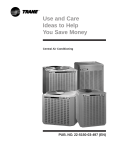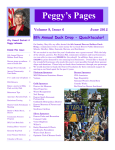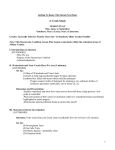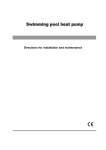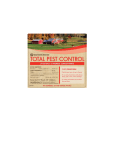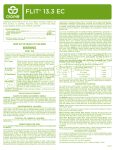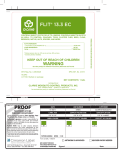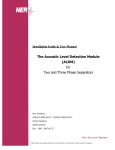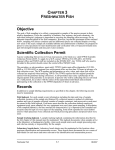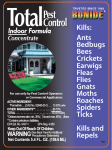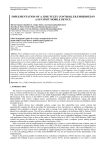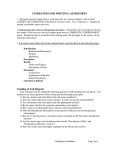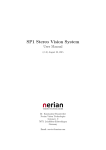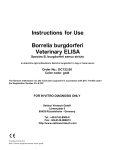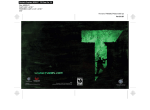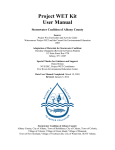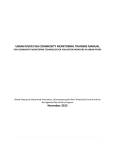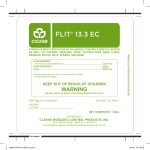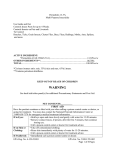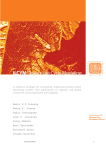Download BMI Sampling & Identification Manual
Transcript
COLDWATER CONSERVATION CORPS Advanced Monitoring Protocol Macroinvertebrate Sampling And Assessment February 2014 INTRODUCTION Since 2008, Pennsylvania has experienced a significant increase in resource development in the form of unconventional shale gas extraction. Natural gas extraction from several deep shale formations, most notably the Marcellus Shale formation and now the Utica Shale formation, is occurring in areas of Pennsylvania that contain the last remaining strongholds of native and wild trout. Potential threats to coldwater resources exist as a result of shale gas development activities, in the form of land disturbances for well pads, new roads and pipelines, from significant water withdrawals, and from spills and wastewater discharges. In 2010, Trout Unlimited and the Pennsylvania Council of Trout Unlimited created the Coldwater Conservation Corps (CCC)—a volunteer based network of stream stewards who conduct stream monitoring and routine inspections of stream conditions and report problems to the appropriate agencies—to help watch over and protect sensitive coldwater resources. As part of the CCC program, volunteers collect data for five different parameters—pH, water and air temperature, cross-sectional area, conductivity, total dissolves solids (TDS)—from streams in their local watersheds. As of June 2012, approximately 100 CCC volunteers are collecting data on almost 200 streams across the Commonwealth. This macroinvertebrate sampling and analysis protocol is an advanced monitoring protocol that is to be used in conjunction with, and to supplement, the PATU CCC field manual. TU added the macroinvertebrate protocol to further expand on the capabilities of the CCC water quality monitoring program, providing a more in-depth snapshot of stream health. By taking an ecosystem approach to monitoring, CCC volunteers can now track physical, chemical, and biological changes in their stream as well as timestamp stream health that may potentially be at risk from long-term effects from shale development. The TU Coldwater Conservation Corps Advanced Monitoring manual is to be used with TU’s Macroinvertebrate Survey and Assessment Field Data Sheet. See Appendix A. Additional resources are available in Appendix B. The biotic index and sampling protocol that the TU Coldwater Conservation Corps has developed for coldwater resources was adapted from: Volunteer Stream Monitoring: A Method’s Manual, United States Environmental Protection Agency, Office of Water, Draft Document #EPA 841-B-97-003, November 1997; Pennsylvania Senior Environmental Corps: 2011 Pennsylvania Volunteer Water Quality Monitoring Field and Test Kit Manual. 2011; Citizen Monitoring Biotic Index, Water Action Volunteers, Volunteer Stream Monitoring Factsheets Series, 2010. Equipment Provided: Kick net (preferably 1/16 or 1/32 mesh size) White dishpan or shallow tray Ice cube trays Magnifying lens Macroinvertebrate identification sheets Field data sheets Time Needed: Up to 45 minutes When to Sample: Sample between October and May At least once yearly, but twice per year is recommended (once in fall and once in spring) Volunteers Provide: Fishing License GPS Waders Additional plastic containers Damselfly Larva Macroinvertebrates are useful indicators of the health and condition of a stream. Macroinvertebrates are small organisms without backbones whose presence or absence can reflect a stream’s general health. They respond to many kinds of pollution, including short and long term chemical or biological pollution. Macroinvertebrates may show responses to pollution or other impairments, such as sedimentation or habitat loss, that are not easily detected by traditional water quality parameters. With the increase in unconventional shale gas development and the potential for multiple types of impacts to coldwater streams, it is important to augment our basic water quality monitoring effort and take an ecosystem approach to stream conservation. In addition to testing for chemical parameters that identify high conductivity and total dissolved solid concentrations, a macroinvertebrate biosurvey will improve our ability to detect stream health and ensure there is plenty of food for trout to eat! By sampling macroinvertebrates, volunteers can index the quality of water in the stream based upon the number and species of aquatic insects they find. Some species are classified as pollution tolerant – capable of living in an environment with a wide range of water quality – while other species are classified as pollutant sensitive – incapable of living in an environment with a wide range of water quality. Streams with primarily pollutant tolerant species generally have lower water quality than streams that have a majority of pollutant sensitive species. The presence or absence of some species can serve as a useful indicator of environmental conditions. A healthy stream will have a diversity of macroinvertebrates – both pollutant tolerant and pollutant sensitive species. In a few cases, particularly in headwater streams, certain pristine environments will have a low diversity of macroinvertebrates because of the cold temperatures and low nutrient levels. In order for volunteers to participate in macroinvertebrate sampling, an index was created to allow for aquatic insect identification at a coarser resolution. Entomologists identify macroinvertebrate to the species level, but this method is not feasible for the citizen scientist because extensive training and additional equipment is needed. In order to index macroinvertebrates and determine water quality, citizen scientists will be identifying macroinvertebrates to the Linnaean taxonomic rank of Order. At this level, volunteers will be able to identify most insects with the naked eye and the remaining insects using a hand lens. SAMPLING PROTOCOL Key Points Sampling area is 1 meter by 1 meter Remember to turn over larger rocks by hand and dislodge any insects into the kick-net Hold net at 45° angle Check rocks for organisms and then set them outside the sampling area Avoid sampling areas with large, heavy boulders Water Penny Cranefly Larva Macroinvertebrates will be sampled in streams that have riffles and cobble/gravel substrates. You will conduct benthic macroinvertebrate sampling at least once a year, between October and May. You will collect two or three samples at each site using a kick net. You will combine the tally of organisms from your samples in order to obtain a sample that is large enough to analyze. After two samplings, if you do not have at least 200 organisms, then you will need to collect a third sample. In order to sample macroinvertebrates, volunteers will need to have a current Pennsylvania fishing license. 1.) Identify the Reach and Sampling Locations You will need to identify a 30 meter-reach of your stream where riffles are present and the stream is accessible. The monitoring location where you conduct your basic water quality monitoring for the Coldwater Conservation Corps program will often work, unless you are monitoring by a bridge or other man-made structure such as a wall, storm drainpipe, tractor crossing, dam, etc. In this case, it is best to work upstream from the bridge, making sure the downstream end of the reach you are monitoring is at least 15 meters upstream of the structure. If working upstream from the structure is not an option, move at least 35 meters downstream before you designate your stream reach. Try and select your stream reach as far away from any obstacles, such as bridges or culverts, as practicable. Mark your stream reach using landmarks or small rock cairns along the stream and choose three locations within the reach to use as potential sampling spots. The three locations should be in riffles. Riffles are highly utilized by macroinvertebrate organisms because they are well oxygenated and provide food particles. If your reach does not contain a riffle sequence, locate three “run” areas with adequate cobble substrate, in order to maximize your chances of collecting a representative and diverse sample of the reach. Key Points Anchor the net to the stream bed with rocks Avoid lifting rocks that are very heavy Kick the stream bed for approximately three minutes or until you are confident that the stream bed has been thoroughly stirred up 2.) Identifying & Preparing the Downstream Site First Of the three sampling locations you chose, you should sample your downstream site first and always enter the stream and approach your sampling site from the downstream end. This keeps you from dislodging any sediment and macroinvertebrates and biasing your 2nd and 3rd samples. At your sampling site, select a 1 meter by 1 meter riffle area. The area should consist of mixed cobble, small boulder substrate. Gravel beds and sand should be avoided, if at all possible. Work in teams of two, with one person minding the net and the other person responsible for shuffling rocks. The person minding the net should be down stream of your selected site and facing upstream. With the net in the water, the kick net handles should be at a 45° angle with the water surface and the bottom of the net should be tight against the stream bed. Use rocks from the sampling area to anchor the net to the stream bottom, if needed. The stream should flow through the net but not flow over the top of the net. 1m X 1m Mayfly Nymph 3.) Scud Dislodging the Macroinvertebrates The rock shuffler should stand upstream, within the 1 meter by 1 meter sampling area. Initially, pick up any large rocks (e.g., boulders > 10 inches) and look on the bottoms for any organisms, particularly case building caddisfly larvae. Using your hand, whisk the organisms into the net. Set the boulders outside the sampling area when done. Continue examining larger boulders for bugs until there are no large rocks left in the sampling area. Once the sampling is complete, boulders should be returned to the sampling area. Key Points Before lifting the net, check the anchor rocks for insects and remove them from the net Replace rocks back into sampling area when done Check and double check net debris for unseen organisms Dobsonfly Larva Sowbug If possible, try and avoid sampling areas with extremely large and heavy boulders. Please do not injure yourself trying to move large boulders. Once the larger substrate or rocks has been removed, start at the upstream end of your sampling area and thoroughly disturb two to three inches of the stream bed with your feet, slowly working your way towards the net. Stop when you reach the net and are certain that you have thoroughly stirred up the streambed substrate within your sampling area. The whole process should take approximately three minutes, but it is more important to do a thorough job than to adhere to a specific timeframe. Before picking up the net, remember to remove the rocks that have been anchoring the net to the streambed. Be sure to inspect the anchor rocks for any rogue insects. Key Points Before lifting the net, check the anchor rocks for insects and remove them from the net Replace rocks back into sampling area when done Check and double check net debris for unseen organisms Mayfly Larvae Stonefly Larva Scud Dragonfly Larvae Stonefly Larvae Dragonfly Larva 4.) Remove the Net and Collect the Macros When removing the net, it is critical that you do so without allowing any of the organisms that the net contains to wash away. With the net-minder holding onto the handles of the net, the rock shuffler should grab the bottom of the net, near the handles. Turning the bottom of the net at an angle to ensure no organism escapes, grab both handles and with a forward scooping motion, remove the net from the water. On shore, spread the net out on the stream bank and begin picking through the net contents. Place the collected organisms in a bucket or container with approximately ½ inch of water in the bottom. It is important to do this as quickly as possible because macroinvertebrates will eventually dry out and die. You will most likely have some debris in your net that was displaced from under rocks and it is important that you collect this material because it often harbors hiding insects. Place the debris into a bucket with about an inch of water in the bottom. Look over the net one last time and make sure there are no organisms still in the net. Key Points Sort your samples using ice-cube trays Gauge how many samples you will need to do after your first sampling. Combine all your samples together before separating Should you take another sample? If you have….. < 200 organisms Fewer than 5 Orders represented Fewer than 4 different kinds of sensitive organisms …..then, you should take another sample. Repeat steps 2-4 for your second sampling. After the second sampling, estimate the number of organisms. If you have less than 200 organisms, collect a third sample and repeat steps 2-4. **Note** Depending on how many macroinvertebrates you collected in your first sample, you may want to wait until you sample all of your sites before separating bugs into the sorting trays. Ultimately, your analysis will be based on your total collection and sorting each sample individually will take extra time. **Important** Life in the stream is naturally non-uniform. You will get a better representation of the macroinvertebrate community by analyzing at least two samples from two different kicks. It will be up to you to decide whether a third sampling will yield better results for your stream. A general rule of thumb to follow is if you have less than 200 organisms or fewer than 5 Orders of organisms or fewer than four different kinds of sensitive organisms in your combined first and second net samples you should sample one additional site. See the Macroinvertebrate Survey and Assessment data sheet for organism grouping. Other tips to help you decide if additional sampling should be done: •Life is abundant and not overwhelmingly dominated by just one or two somewhat sensitive or tolerant orders •Ten or more kinds of organisms are in the collection •Four or more sensitive kinds of organisms are in the collection •The individual dominant organism (most abundant) is sensitive •Collectively, the number of “sensitive” organisms dominate the sample. •Mayflies, stoneflies, and caddisflies—all three insects—are present. If all these factors are true for your samples, additional sampling is not needed. Alderfly Larva 5.) Sorting Macroinvertebrate Organisms Placing small amounts of debris into a white dishpan (any large shallow white pan) that is partially filled with stream water will allow you to see the small moving organisms much easier. Key Points 200 organisms for analysis unless conditions dictate otherwise Sort through debris to ensure all macroinvertebrates are accounted for. Place similar organisms in same section of sorting tray Look for anything that swims, crawls, wriggles, or is hiding in a shell. You can use a set of tweezers or a similar tool to remove the organisms. It is often hard to see these organisms, so using a white pan to check, and double-check, for bugs is always a good idea and cannot be emphasized enough. Once all the debris has been sorted through, you can begin to sort through your collected organisms. Pour the bucket or container containing your collected organisms into the white dishpan. Sort through the organisms and move them to the sorting trays (ice-cube trays) placing similar organisms in the same section of the sorting tray. Caddisfly Larvae 6.) Collect Additional Samples Repeat steps 2-5 for the second sampling location and third sampling location, if you decide additional samples are needed. You should be working with a minimum of 200 organisms for your analysis unless your stream dictates otherwise. Key Points Make sure you fill out the data sheet entirely Don’t forget your Fishing License Use a hand lens or magnifying glass for identifying small organisms Use additional sources if needed for identification Return organisms to the stream Clean up equipment before leaving site Calculate water quality rating 7.) Identify Macroinvertebrate Organisms Use a hand lens, referencing the macroinvertebrate identification sheets, to identify your organisms. You may use additional field guides and identification keys, besides those provided with your kit, to help with identification. Record the observed number of organisms on your field data sheet. Once the collection and identification phases are complete, return the organisms to the stream near the area they were collected. Wash and clean up your equipment with stream water. Blackfly Larvae 8.) Calculate Water Quality Rating Please assign one of the following abundance codes to each type of organism you collected. Record the code next to the actual count for each organism on the Macroinvertebrate Survey and Assessment Data Sheet. R (rare) = 1-9 organisms found in the sample. C (common) = 10-99 organisms found in the sample D (dominant) = >100 organisms found in the sample. 1-9 : Rare (R) 10-99 : Common (C) 100+ : Dominant (D) The field data sheet divides the macroinvertebrate organisms into three groups based on their sensitivity to pollution. The three tolerance groups are as follows: Group I – Organisms that are sensitive to pollution and are typically found only in good water quality and/or habitat. Group II – Organisms that are somewhat sensitive to pollution and are typically found in good or fair quality of water and or habitat. Group III - Organisms that are tolerant of pollution and are typically found in all but the poorest-quality water and/or habitat Follow the instructions on the Macroinvertebrate Survey and Assessment Data Sheet (Appendix A) to calculate the various metrics and determine your stream’s water quality rating! It should be noted that the stream Water Quality Score sensitivity rating used in this manual and field data sheet is based on types of organic pollution and not on pollution due to metals. Therefore, some organisms that are not sensitive to metals that should only be found in good-quality water may be found in acid mine drainage (AMD) affected streams. In general, even though our index does not include sensitivity to metals, almost all sensitive taxa will still most likely decrease in a stream that is affected by AMD discharge and other forms of pollution, and thus this method will still provide an accurate indication of the macroinvertebrate community in this impaired stream. COLDWATER CONSERVATION CORPS Advanced Monitoring Protocol APPENDIX A Macroinvertebrate Assessment Sheet Macroinvertebrate Survey and Assessment Monitor Name(s): Date: Stream Name: GPS Location: Naming Convention: Macroinvertebrate Count Identify the macroinvertebrates (to order) using the identification sheets. We are only concerned with organisms that appear on the identification sheets. Record the number of organisms in the table below and assign them letter codes based on their abundance. C (Common) = 10-99 R (Rare) = 1-9 D (dominant) = 100+ EXAMPLE: 23 ( C ) Stonefly Nymphs or 8 ( R ) Aquatic Worms or 117 ( D ) Sowbugs Group I - Sensitive ( ( ( ( ( ) ) ) ) ) ( ( ) Stonefly Nymphs ) Non-net Spinning Group II - Somewhat Sensitive Water Penny Larvae Hellgrammites Mayfly Nymphs Gilled Snails Riffle Beetle Adults Caddisfly Larvae ( ( ( ( ( ) ) ) ) ) Beetle Larvae ( ( ( ( ( ( ) ) ) ) ) ) Dragonfly Nymphs Clams Cranefly Larvae Crayfish Damsefly Nymphs Group III - Tolerant ( ( ( ( ( ) ) ) ) ) Aquatic Worms Blackfly Larvae Leeches Midge Larvae Snails Scuds Sowbugs Fishfly Larvae Alderfly Larvae Net Spinning Caddisfly Larvae Water Quality Rating To calculate the index value, add the number of letters found in the three groups above and multiple by the indicated weighting factor. Group I - Sensitive Group II - Somewhat Sensitive Group III - Tolerant (# of R's) X 5.0 = (# of R's) X 3.2 = (# of R's) X 1.2 = (# of C's) X 5.6 = (# of C's) X 3.4 = (# of C's) X 1.1 = (# of D's) X 5.3 = Index Sum Total (# of D's) X 3.0 = Index Sum Total (# of D's) X 1.0 = Index Sum Total To calculate the water quality score of the stream site, add together the index sum total for each group. The sum of these values equals the water quality score. Group I - Sensitive Compare this score to the following number Group II - Somewhat Sensitive ranges to determine the quality of your Group III - Tolerant Water Quality Score stream site Good >40 Fair 20-40 Poor<20 Macroinvertebrate Survey and Assessment Monitor Name(s): Date: Stream Name: GPS Location: Naming Convention: Macroinvertebrate Count Identify the macroinvertebrates (to order) using the identification sheets. We are only concerned with organisms that appear on the identification sheets. Record the number of organisms in the table below and assign them letter codes based on their abundance. C (Common) = 10-99 R (Rare) = 1-9 D (dominant) = 100+ EXAMPLE: 23 ( C ) Stonefly Nymphs or 8 ( R ) Aquatic Worms or 117 ( D ) Sowbugs Group I - Sensitive ( ( ( ( ( ) ) ) ) ) ( ( ) Stonefly Nymphs ) Non-net Spinning Group II - Somewhat Sensitive Water Penny Larvae Hellgrammites Mayfly Nymphs Gilled Snails Riffle Beetle Adults Caddisfly Larvae ( ( ( ( ( ) ) ) ) ) Beetle Larvae ( ( ( ( ( ( ) ) ) ) ) ) Dragonfly Nymphs Clams Cranefly Larvae Crayfish Damsefly Nymphs Group III - Tolerant ( ( ( ( ( ) ) ) ) ) Aquatic Worms Blackfly Larvae Leeches Midge Larvae Snails Scuds Sowbugs Fishfly Larvae Alderfly Larvae Net Spinning Caddisfly Larvae Water Quality Rating To calculate the index value, add the number of letters found in the three groups above and multiple by the indicated weighting factor. Group I - Sensitive Group II - Somewhat Sensitive Group III - Tolerant (# of R's) X 5.0 = (# of R's) X 3.2 = (# of R's) X 1.2 = (# of C's) X 5.6 = (# of C's) X 3.4 = (# of C's) X 1.1 = (# of D's) X 5.3 = Index Sum Total (# of D's) X 3.0 = Index Sum Total (# of D's) X 1.0 = Index Sum Total To calculate the water quality score of the stream site, add together the index sum total for each group. The sum of these values equals the water quality score. Group I - Sensitive Compare this score to the following number Group II - Somewhat Sensitive ranges to determine the quality of your Group III - Tolerant Water Quality Score stream site Good >40 Fair 20-40 Poor<20 Macroinvertebrate Survey and Assessment Monitor Name(s): Date: Stream Name: GPS Location: Naming Convention: Macroinvertebrate Count Identify the macroinvertebrates (to order) using the identification sheets. We are only concerned with organisms that appear on the identification sheets. Record the number of organisms in the table below and assign them letter codes based on their abundance. C (Common) = 10-99 R (Rare) = 1-9 D (dominant) = 100+ EXAMPLE: 23 ( C ) Stonefly Nymphs or 8 ( R ) Aquatic Worms or 117 ( D ) Sowbugs Group I - Sensitive ( ( ( ( ( ) ) ) ) ) ( ( ) Stonefly Nymphs ) Non-net Spinning Group II - Somewhat Sensitive Water Penny Larvae Hellgrammites Mayfly Nymphs Gilled Snails Riffle Beetle Adults Caddisfly Larvae ( ( ( ( ( ) ) ) ) ) Beetle Larvae ( ( ( ( ( ( ) ) ) ) ) ) Dragonfly Nymphs Clams Cranefly Larvae Crayfish Damsefly Nymphs Group III - Tolerant ( ( ( ( ( ) ) ) ) ) Aquatic Worms Blackfly Larvae Leeches Midge Larvae Snails Scuds Sowbugs Fishfly Larvae Alderfly Larvae Net Spinning Caddisfly Larvae Water Quality Rating To calculate the index value, add the number of letters found in the three groups above and multiple by the indicated weighting factor. Group I - Sensitive Group II - Somewhat Sensitive Group III - Tolerant (# of R's) X 5.0 = (# of R's) X 3.2 = (# of R's) X 1.2 = (# of C's) X 5.6 = (# of C's) X 3.4 = (# of C's) X 1.1 = (# of D's) X 5.3 = Index Sum Total (# of D's) X 3.0 = Index Sum Total (# of D's) X 1.0 = Index Sum Total To calculate the water quality score of the stream site, add together the index sum total for each group. The sum of these values equals the water quality score. Group I - Sensitive Compare this score to the following number Group II - Somewhat Sensitive ranges to determine the quality of your Group III - Tolerant Water Quality Score stream site Good >40 Fair 20-40 Poor<20 COLDWATER CONSERVATION CORPS Advanced Monitoring Protocol APPENDIX B Pennsylvania Senior Environmental Corps Biosurvey Identification Chart Field Manual 2011 Pennsylvania Senior Environment Corps Biosurvey: Identification Chart (p 1 of 6) Bar lines next to each organism indicate relative size. Group I – sensitive Water Penny Larvae - Order Coleoptera: 4-6 mm flattened disclike forms, found clinging to rocks a dorsal plate conceals the head and 6 legs. Dobsonfly Larva (Hellgrammite) - Order Megaloptera: 25-90 mm, dark colored, 6 legs, well developed chewing mouthparts, 2 short antennae, 8 abdominal segments each with a pair of filaments; 2 anal prolegs with hooks; has gill tufts at base of legs. Mayfly Nymph - Order Ephemeroptera: 3-20 mm (not including tails), elongate, cylindrical to flattened form, head with slender antennae, 6 legs with one claw or no claw, wing pads present, platelike or feathery gills along abdomen, 3 long tails (sometimes 2). Gilled Snail - Class Gastropoda: vary in size; a thin, horny plat, the operculum, seals the opening to the shell when the foot is retracted. Riffle Beetle - Order Coleoptera: 1-8 mm, oval elongate body, 6 legs, crawl underwater; antennae usually slender but are sometime clubbed. Stonefly Nymph - Order Plecoptera: 5-35 mm (not including tails), 6 legs with clawed tips, long slender antennae, 2 tails,gills may be present on mouthparts, thorax, and/or legs, gills, rarely present on abdomen,hardened thoracic segments. 66 Field Manual 2011 Pennsylvania Senior Environment Corps Biosurvey: Identification Chart (p 2 of 6) Group I – sensitive (continued) Non-Net Spinning (Case building) Caddisfly Larva – Order Trichoptera: 2-40 mm, usually found within a case attached to the bottom of rocks, case made of plant material or rock particles, long and caterpillar-like, distinct head, chewing mouthparts, antennae reduced or inconspicuous, 3 pairs of legs, no wing pads or tails, end of abdomen has prolegs each with a claw. 67 Field Manual 2011 Pennsylvania Senior Environment Corps Biosurvey: Identification Chart (p 3 of 6) Group II - somewhat sensitive Beetle Larvae - Order Coleoptera: 2-60 mm, distinct head, 2 antennae, 6 legs, 8 to 10 segmented abdomen, may or may not have abdominal gills orlateral filaments. Clams - Class Pelecypoda: 2-250 mm, two-piece (bivalve) shell, commonly oval with concentric growth lines. Cranefly Larva - Order Diptera - Family Tipulidae: 10 - 100 mm (sometimes larger), white, green or brown caterpillar-like body, segmented, abdomen may be bulbous or end in fleshy projections. Crayfish - Order Decapoda: 10-150 mm, 2 large claws, 8 legs, 2 long antennae, resembles a tiny lobster. Damselfly Nymph - Order Odonata -Suborder Zygoptera: 10-30 mm, elongate and slender forms, 2 antennae, 6 legs, 2 pairs of wing pads, no gills along body, 3 leaflike “tails” (actually the gills) on end of abdomen; distinctive lower lip is large and extendable. Dragonfly Nymph - Order Odonata - Suborder Anisoptera: 12-15 mm, large eyes, wide oval to round abdomen, 6 hooked legs, gills in rectum. 68 Field Manual 2011 Pennsylvania Senior Environment Corps Biosurvey: Identification Chart (p 4 of 6) Group II - somewhat sensitive (continued) Scud - Order Amphipoda: 5-20 mm, laterally flattened, white to grey, swims sideways, 7 pairs of legs (first two pairs modified for grasping), resembles a shrimp. Sowbug - Order Isopoda: 5-20 mm, 7 pairs of legs (first pair modified for grasping), 2 antennae, flattened body, top to bottom. Fishfly Larva - Order Megaloptera - Family Corydalidae: 1025 mm, reddish-tan often with yellowish streaks, no gill tufts underneath abdomen, resembles a small hellgrammite; have 2 breathing tubes on last abdominal segment; 2 anal prolegs with hooks. Alderfly Larva - Order Megaloptera - Family Sialidae: 10-25 mm, abdomen with 7 pairs of 4 to 5 segmented lateral filaments and a single unbranched terminal filament. Net-Spinning Caddisfly Larva - Order Trichoptera Family Hydropsychidae: 10-16 mm, strongly curved body, 3 thoracic segments that are sclerotized (hardened), branched gills on ventral side of abdominal segments, (abdomen covered with small hairs), 2 anal prolegs each with tuft of long hair and a hook, no case (free-living). Family Philopotamidae: 10-12 mm, only first thoracic segment (pronotum) sclerotized (hardened), sometimes yellow or orange, head and pronotum brownish orange, pronotum bounded posteriorly by pronounced black line, 3 pairs of legs, no anal prolegs or abdominal gills, abdomen strongly curved, no case (free-living). 69 Field Manual 2011 Pennsylvania Senior Environment Corps Biosurvey: Identification Chart (p 5 of 6) Group II - somewhat sensitive (continued) Family Polycentropodidae: 10-25 mm, whitish color tinged with purple, abdomen usually has a lateral fringe of short hairs but never possesses gills, lower end of abdomen strongly curved; 2 anal prolegs. 70 Field Manual 2011 Pennsylvania Senior Environment Corps Biosurvey: Identification Chart (p 6 of 6) Group III - Tolerant Aquatic Worm – Class Oligochaeta: 1-30 mm (sometimes over 100 mm), elongate, cylindrical worms, segmented body (may be difficult to see segments), color variable. Blackfly Larva - Order Diptera - Family Simulidae: 3-12 mm, cylindrical body with one end wider, black head with fanlike mouth brushes. Leech - Order Hirudinea: 5-100 mm, flattened segmented body, both anterior and posterior suckers. Midge Fly Larva - Order Diptera Family Chironomidae: 2-20 mm, slender and cylindrical curved body, dark head with 2 prolegs on each side of the bottom of the first segment behind the head. Other Snails - Class Gastropoda: non-gill breathing snails, do not have an operculum to close the shell opening. 71 COLDWATER CONSERVATION CORPS Advanced Monitoring Protocol APPENDIX C Additional Resources Glossary of Terms for Aquatic Macroinvertebrates (Source: NY Dept. of Environmental Conservation) Abdomen - The area of the body behind the head and the thoracic segments. Abdominal - Pertaining to structures on the abdomen. Antenna (pl. antennae) - Sensory appendage on the head located between the eyes. They may be several times longer than the width of the head or extremely small and difficult to see even when magnified. Anterior - At or directed toward the head or forward part of the body. Apical - At the end or tip of a structure. Aquatic - Living in or on water. Chaetae - Hairlike bristles in worms. They can be very long, several times longer than the width of the body or just protruding from the body. These are mostly microscopic and difficult to see at less than a magnification of 100x. Dorsal - Pertaining to the top or upper surface. The opposite of ventral. Dorsal hump - A single wart-like structure found on the top of the first abdominal segment. It may be very prominent or appear as only a slight mound. Best seen in side view. Exoskeleton - The hardened outside body wall of arthropods. Gill - A structure that allows an orgasm to breath underwater. They are variable in length and form; from thread-like to plate-like. Glossa - One of a pair of two lobes near the middle of an insects mouth. Hind legs - The third pair of legs, the most posterior pair of legs. Kick sample - A method of collecting aquatic macroinvertebrates from a wadable stream or river. A net or screen is held downstream at arms length and the substrate is disturbed by foot. Organisms are dislodged from the substrate and are carried by the current into the net. Labium - The lower "lip" of the insect head. Labrum - The upper "lip" of the insect head. Larvae - The first life stage of insects; a developmental stage with many instars (the insect between molting) before becoming a winged adult. Lateral humps - Paired wart-like structures that are found on the sides of the first abdominal segment. These may be very prominent or appear as only slight mounds. Best seen when looking at the larva from the top. Macroinvertebrate - A small animal generally visible to the unaided eye, usually larger than 0.5 mm. These animals do not have a backbone. Maxillary palp - One of a pair of segmented appendages located between the mandibles of insects. Mesonotum - The middle sclerotized plate on the top of the thoracic segments. Metamorphosis - The change of an animal from one form to another. e.g. the transformation of a larva to a pupa, or pupa to adult. Mottled - Patterned with spots or blotches. Nota - The dorsal surface of a body segment, especially of the thoracic segments. Nymph - The immature or larval stage of some macroinvertebrates. Omnivorous - Feeding on both animals and plants. Paraglossa - One of a pair of two lobes near the middle of an insects mouth. These surround the glossa. Posterior - At or toward the hind or tail end of the body. Predaceous - Feeding or preying on other animals. Proboscis - A tubular structure protruding from the head. Process - An elongation of a surface, a margin or an appendage. Proleg - A fleshy, unsegmented, leglike or lobelike structure. They can be single but often occur in pairs and can be located under the thorax, along the abdomen, or at the end of the abdomen. Proleg often bear terminal claws. Pronotum - The top surface of the first, most anterior thoracic segment. Prosternal - Underneath the first thoracic segment and between the first pair of legs. Prosternal horn - A slender finger-like structure located just behind the underside of the head in some caddis larvae. Setae -Hairlike structures that can be found on various parts of a macroinvertebrates body. They may be single, in rows, or in clusters. Segment - A subdivision of the body. Sclerotized - Hardened and usually darkened pertaining to the body wall. Sternal - Pertaining to the ventral or underside of a body segment. Subocular line - A line beneath or below the level of the eye. Tarsal - The last segments of the leg. Often divided into two to five tarsal segments. Terga - The upper or dorsal surface of any body segment. Terrestrial - Living on land , instead of water. Thoracic - Of the thorax. (The section of the body between the head and the abdomen) Trochantin - A separate, small, platelike appendage of caddisfly larvae located anteriorly at the base of the foreleg. Thorax - The part of the body between the head and the abdomen. Ventral - Pertaining to the bottom or underside. The opposite of dorsal. Wing pads - The encased undeveloped wings of nymphs LARVA Caddis Flies Caddis flies are aquatic insects found in nearly all of Pennsylvania’s waters. Some caddis species are at home in small mountain streams, while others prefer the depths of our large rivers and lakes. Like butterflies and moths, caddises go through complete metamorphosis. Use the letters ELPA to help remember the four stages in complete metamorphosis: Egg, larva, pupa and adult. Caddis larvae look much like worms with six legs. The larvae produce silk, and many use it to build protective cases. They make tube or purseshaped cases out of grains of sand, sticks and other vegetation. One species makes a case that looks like a snail shell. Some species carry the case. Others attach it to rocks. Larvae crawl on the rocks eating algae and other plants. A few species build silken nets to filter food out of the water. In many Pennsylvania streams there is a green-colored caddis larva that is a predator. It does not build a case. EGG PUPA Each egg is very small and round. One egg is about the size of the period at the end of this sentence. Depending on species, the female lays the eggs in clusters of 30 to 300 eggs. The clumps stick to the bottom and hatch in two to four weeks. Nearly a year after it hatches, the larva constructs a cocoon. The larva enters the cocoon and becomes a pupa. A pair of wings develops while inside the cocoon. After about two weeks in the cocoon the pupa appears and swims to the surface. For each kind of caddis this happens at the same time each year. LARVA EGG ADULT illustration-Ted Walke PUPA ADULT Many adults emerge from the pupae just below the water’s surface. Others emerge on the surface. Fish gobble both the emerging pupae and the adults. Adult caddis flies look much like small moths. The adults fly to trees and bushes along the water and after several days will mate there. After mating, the female flies her fertilized eggs to the Cases water. Depending on the species, the egg clusters are deposited on the surface or the female swims the Net clusters to the bottom. Adult caddis flies often live for months after mating. Mayflies NYMPH Mayflies are important food items for many fish, especially trout. There are more than 700 kinds of mayflies in North America. Pennsylvania is home to some 300 different species. Mayflies go through a change called metamorphosis. Unlike butterflies that have four stages (egg, larva, pupa, adult), mayflies go through three stages. This is incomplete metamorphosis. Use the letters ENA to remember each step: Egg, nymph and adult. EGG The period at the end of this sentence is larger than the eggs of most mayflies. Most eggs have hair-like projections that make them stick to the bottom. Eggs hatch after a month, but some types of mayfly eggs take as long as three months to hatch. From the egg, a nymph emerges. EGG The nymphs of some mayflies burrow into the bottom. Others swim about freely, cling on rocks or crawl around on the bottom. Some are predators; others eat live or decaying plants. As they eat and grow, nymphs shed their skins. One mayfly sheds some 45 times. Most mayflies live in streams and some rivers, but there are a few that live in lakes and ponds. Nearly all Pennsylvania mayflies live as nymphs for one year. At the end of the this stage the mature nymph changes into an adult. This happens at the same time every year for each species when water temperature and day length are just right. The hatch: When nymphs shed their skins and become adults. Some mayfly nymphs swim to the surface, hatching along the way. Others hatch on the bottom and the adult swims to the surface, or they hatch at the surface. Fish go on feeding binges when burrowing this happens. NYMPH nymph Spinner Spinner ADULT The first stage in an adult mayfly is called a dun. The dun cannot reproduce. Duns that swimming survive hatching and nymph reach the surface aren’t safe, yet. Fish often feast on the duns as they rest on the surface. crawling Bats, birds and nymph other insects eat them as they fly away from the water. The duns fly to streamside trees and brush. Most Pennsylvania mayHatching flies change again into a reproducing stage called a spinner. This usually happens within a day or so of hatching. Usually at nightfall, the spinner flies back toward the water to mate. Mayflies mate in big clouds, with the males diving and dipping to attract a mate. Each female may lay as many as 1,200 eggs. She either drops her eggs to the water from above the surface, swims to the bottom to lay eggs, or lands on the water and lays eggs on the surface. After mating, the mayfly dies, and often falls on the water’s surface. These dead mayflies are also eaten by fish. Dun illustration-Ted Walke ADULT Stoneflies ADULT The scientific name for this order of insects is Plecoptera, which in Latin means “braided wing.” The wings of adults have numerous veins, making them appear braided. Stoneflies, as you can guess, live in habitats with plenty of stones. They prefer fast-moving, clear streams with a bottom of rocks and stones. Small mountain brooks and large streams in wooded areas usually have plenty of this type of habitat, and often many stoneflies. Stoneflies, like mayflies, have incomplete metamorphosis. The stages of incomplete metamorphosis include egg, nymph and adult, or “ENA.” NYMPH Stonefly nymphs have two tails and two sets of wing pads or plates. They also have gills on the middle body segment near their legs. Mayflies may have two tails, but their gills are on the last body segment. The nymphal stage of most stoneflies is one year. There are a few species here that take as long as three years to mature. Stoneflies crawl about and cling to the rocky bottom, sheltered from the current. In small streams, many species feast on leaves falling from streamside trees. In GG larger waters they graze on other aquatic vegetation, like that slime or the scum that covers rocks. There are some stoneflies that are predatory. The wings of adult stoneflies fold back flat over the body. Caddisflies also have “laid back” wings, but they almost form a tent over the body. After hatching, the adults fly to streamside vegetation, where they may live from a few days to a few weeks. Many adults do not eat, but those that live as adults longer do eat vegetation, pollen or nectar. The adults attract mates by “drumming”–bouncing up and down on their vegetation perches. They mate on this vegetation and the female takes the fertilized eggs to the water to deposit them. She may skate across the surface, dropping egg packets. This is often when trout eat the adults. A bushy dry fly skated across the surface at this time can bring slashing strikes. wing pads E NYMPH HATCHING Unlike most other insects, stoneflies hatch, or emerge, on dry land. Often the nymph crawls to a streamside rock and the adult emerges. Trout and other fish may eat the nymphs as they make the move to these places. illustrated by Ted Walke ADULT gills drumming hatch






























